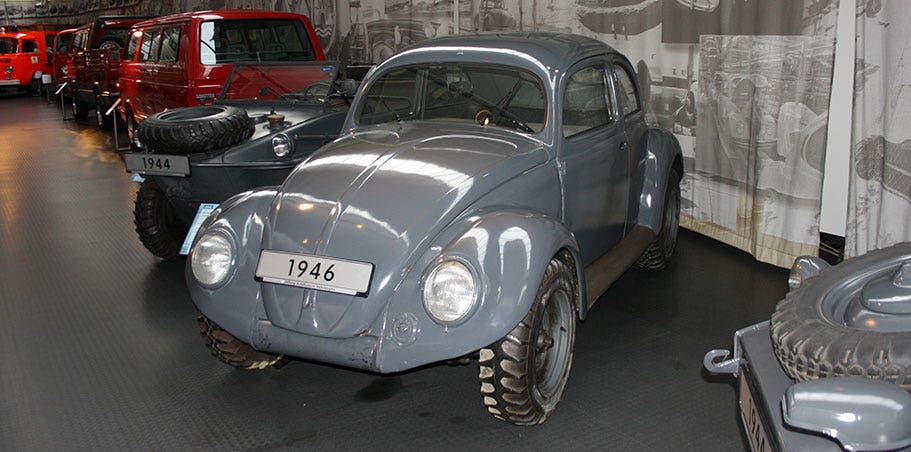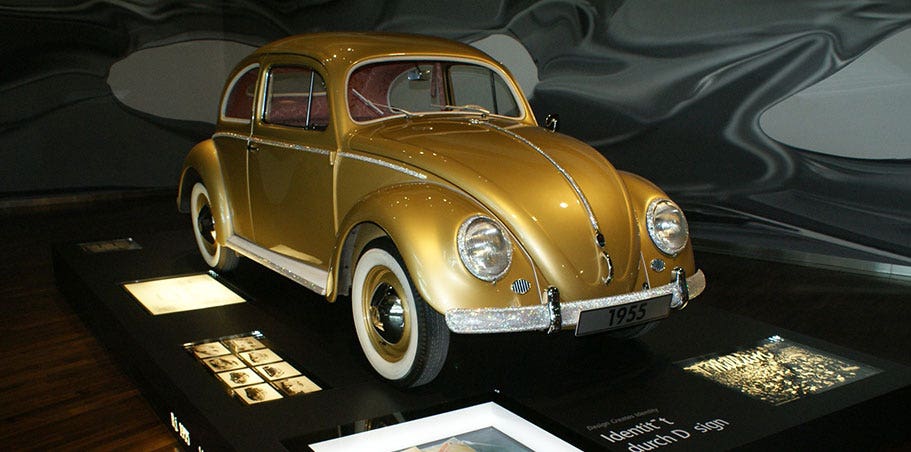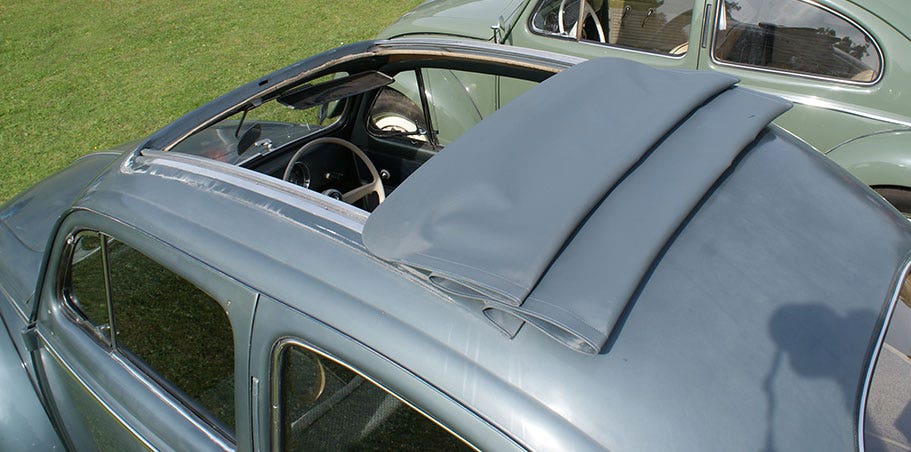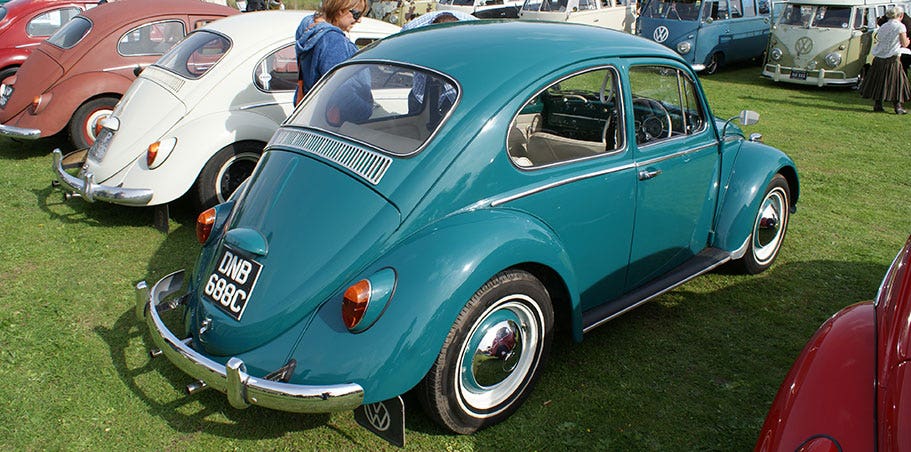Vehicle History | VW Type 1 Beetle


The idea of the Beetle had been conceived in 1931, when Ferdinand Porsche and Zundapp developed the Porsche Type 12, or “Auto fur Jedermann” (translated as “Car for Everyone”). Porsche had already developed the flat 4 cylinder air cooled motor, and Zundapp was developing a Radial 5 cylinder water-cooled power plant. Porsche had chosen to use a “swing-axle” type rear suspension, previously invented by Edward Rumpler.
By 1932, three prototypes were running, and a fourth, the Porsche Type 32, built by the NSU motorcycle factory, joined the line-up in 1933.
In 1933 Adolf Hitler commissioned Porsche to develop a “Peoples Car” (literally a Volks Wagen), the car was to be able to seat 2 adults and 2 children, with room for their luggage, and be able to cruise at 100km/h (62mph). The term “Volks” had been applied to various Nazi party sponsored consumer products such as the Volksradio.
The Volkswagen name however wasn’t to become official until a few years down the line. The new car was initially tagged the Porsche Type 60, then christened the KdF-Wagen, KdF being the initials of the leisure arm of the Third Reich (Kraft durch Freude or Strength through Joy).
October 1935 saw the first Type 60 prototype, known as the "V1" ready. By 1936, testing of the first three "V3" prototypes, built in Porsche's Stuttgart shop, began. By 1937 Thirty "W30" pre-production models, manufactured by Daimler-Benz, had undergone 1,800,000 mi (2,900,000 km) of further testing.
All cars already had the distinctive round shape and the air-cooled, rear-mounted engine.Hitler's plan had been that the new car would be affordable to everyone, and introduced a form of part payment for them, not dissimilar to that of the “Green-Shield” system. Consumers would purchase a “Sparkarte” (a savings card) at a cost of 1 Reichsmark, the equivalent of about 30p, or around 40 US cents.
Following the purchase of the Sparkarte, they were obliged to buy at least 5 Reichsmark of stamps per week, this worked out at roughly £1.35 or $2 USD. The average Germans salary at the time was around 32 Reichsmark a week. The sum total payable for the basic car was 990 Reichsmark.

VW Kommandeurwagon
In 1938, the Stadt des KdF-Wagens had been built around the village of Hesslingen, as a town to house workers at the KdF-Wagen factory.
By the outbreak of World War 2 in 1939, only a handful of consumer cars had been produced, and all customer orders had been cancelled as production was switched from civilian vehicles to that of military vehicles.
The main two vehicles produced during the war period were both Beetle based variants, the flat 4 air cooled engine and rugged suspension being ideal for the harsh desert environments of Africa.
The first was the Type 82 Kubelwagen, a utilitarian off-road vehicle of very basic construction. German military officials had stipulated that the fully laden Kubelwagen (including 4 battle dressed troops) shouldn’t weigh more than 950kg, this left the unladen vehicle with a maximum weight of 550kg. The experienced military coachbuilder Trutz was subcontracted by Porsche to assist with the body design.
Initial testing began in 1938, with successful results, and continued in Poland in 1939. The resulting tests had the German military request some important changes. Whilst the vehicle had impressive off-road credentials, even when compared to some of the existing 4x4s already in service, it was felt it could still be improved, and the vehicles slowest speed of 5mph needed to be reduced to that of marching troops, around 2.5mph.
Porsche responded to these requests by installing “reduction boxes” (effectively a 2nd gearbox, resulting in more torque), larger wheels, and revised suspension. The reduction boxes alongside the self locking ZF differentials increased the vehicles off-road ability, as well as allowing a lower speed to stay level with the troops. Kubelwagens were mass produced as soon as the factories in Stadt des KdF-Wagens had been completed.
The second vehicle produced during the period was the Type 166 Schwimmwagen, based on prototype 4x4 Kubelwagens, the Schwimmwagen was produced as an offroad amphibious vehicle, utilizing an extended crankshaft to drive a folding propeller mounted to the rear of the vehicle.
Due to the simple nature of the propeller coupling, the Kubelwagen could only use propeller power for forward motion, reversing was done by either rowing, or using the land wheels to slowly reverse the vehicle. Steering was controlled by the steering wheel on both land and water, with the front wheels acting as rudders when in boat mode.
The basic 4x4 system was only available to use in 1st gear (and on some models reverse). There was a third military variant of the Beetle, which was called the Kommandeurwagen, or Type 87. This was the rarest of the military models, reserved for German Military VIPs with only 669 rumoured to have been produced. The Kommandeurwagen was a hybrid of a 4x4 Kubelwagen and Beetle, using the Kubelwagen chassis, with a conventional Beetle body on the top.
It is suggested that a lot of the Beetles design features were influenced by that of the Czech manufacturer Tatra, and their chief engineer Hans Ledwinka. It is cited in the book “Car Wars” that Ferdinand Porsche admits to having “…looked over Ledwinka’s shoulder” whilst penning out the initial ideas for the Beetle.
The rear mounted air-cooled engine could also be said to have been borrowed from Tatra as well. Air cooled technology was demanding in the 1930’s, and only subsidies from the Nazi Government meant the development of such a method could be continued by Porsche. In another quote from “Car Wars” Adolf Hitler is quoted as saying “the [Tatra] kind of car I want for my highways”.
The similarity between the two designs clearly hadn’t gone unnoticed by the likes of Tatra, who launched a lawsuit, which was then swiftly dropped following the Third Reich’s invasion of Czechoslovakia, later to be persued by Tatra following the end of the war. The ensuing 1961 lawsuit ruled in favour of Tatra, and resulted in Volkswagen being ordered to pay a sum of 3,000,000 Deutsch Marks to Tatra.
This swallowed up a sizeable portion of VW’s development budget and led to the Beetle being one of the longest running production vehicles of all time.
Whilst some civilian Beetles had been produced during the war, predominantly for high ranking Nazi elite, production was minimal, though some unusual fuelling options became available, in part due to all available oil, and fuel being directed towards the Luftwaffe and Panzer divisions.
One of the more abstract models was the Holzbrenner; essentially a wood powered Beetle. The way this worked was that wood was heated until it began to break down chemically. When wood burns in a normal fire, the wood decomposes chemically due to the heat, and some of the gasses produced by the wood are flammable, and they burn as they are released. That is the flame that you see.
With the world war 2 era wood burning cars, however, wood was heated to a temperature hot enough to decompose the wood, but the gas was not allowed to burn. It was stored in a chamber, and injected into the cylinders of a regular internal combustion car. Some of the German made wood-burning cars were the VW Kdf Wagen (postwar Beetle), and the German Army Kübelwagen.
Following the end of the war, allied forces followed the Morgenthau plan, with the aim of “pastoralizing” Germany, preventing them building up any sort of armaments. As a result German car production was not allowed to exceed 10% of that of 1936 production. The VW plant was taken under the control of the US armed forces.
Opinion in the United States was not flattering, however, perhaps because of the characteristic differences between the American and European car markets. The Ford company was offered the entire VW works after the war for free. Ford's right-hand man Ernest Breech was asked what he thought, and told Henry II, "What we're being offered here, Mr. Ford, isn't worth a damn!" With that, the Ford Motor Company lost out on the chance to build the world's most popular car since their own Model T.
In 1945 the Americans handed control of the factory to the British, the initial plan had been to disassemble the entire factory, and ship it to Britain, however no British company was interested in the company. "the vehicle does not meet the fundamental technical requirement of a motor-car ... it is quite unattractive to the average buyer ... To build the car commercially would be a completely uneconomic enterprise."The re-commissioning of the VW factory is heavily credited to British Army Officer Major Ivan Hirst, who was ordered to take control of the factory, which had suffered heavy bomb damage during the war. One of the first tasks Hirst was given was to remove an unexploded bomb, which having fallen through a roof, had lodged itself between some essential and irreplaceable parts of production equipment. Had Hirst failed in this task, the Beetle would have been consigned to the history books, and things would have been very different.
Following the Allied bombing of Fallersleben, damage to the factory was estimated that 38% of the factory had been rendered useless, of the 17,000+ residents of Fallersleben were over half were VW employees, Hirst soon permitted the Germans to return to work, and by May 1945, they had produced 2 Beetles from various parts gathered from the remains of the factory, a further 56 cars were produced in 1945, not vastly different to that of the pre-war cars, save for different inner front wings, front beam, and the newer 1131cc engine that had been used in the Kubelwagen.
Convinced by Hirst, the British Army ordered 20,000 Beetles, his goal for 1946 was to achieve production levels of 1,000 cars per month. This was not an easy task, as well as limited materials and resources to contend with he also had to feed the workforce, following on from the harshness of the wartime years, the simple lunch that Hirst provided for the workers was more often than not the only meal they received.
By the end of 1946 10,020 Beetles (including a few Kommadeurwagens) had been made, so he was close to the original target. Changes over the year were minimal, mostly simple manufacturing changes with production methods being changed. Tyres however did gain ½” in width, and cardboard sound deadening was fitted to the engine bay.
In 1947 the Beetle was debuted at Hannover fair, and was met with a excited reception, previously the majority of the cars had been for military use, with only a few exceptions going to civilians. It was around this time that Dutchman Ben Pon appeared on the scene (Pon is credited with coming up with the concept for the VW Type 2). He saw a future in exporting the new VW to the Netherlands, and ordered 6 cars.
When time came for him to collect the cars, he and 5 other staff traveled to Wolfsberg to bring them back, however one of the 6 cars failed it’s final inspection, and couldn’t be taken away. Production numbers for 1947 were less than 1946, as whilst efficiency was up, and the factory was being constantly repaired, there was simply not enough coal to keep the factory running over the winter months, causing a three month closedown.
Again changes were minimal for the 1947 model year, with bearing and bearing cap changes on the front and rear axles, an improved spare wheel chain and bracket, and a change to the cooling air throttle ring. 1948 saw the ex Opel manager, Heinz Nordhoff was take full control as director of the Volkswagen factory, and plans for a redesigned Beetle were hatched.
In the same year, the Reichmark was replaced by the Deutschmark, and East and West Germany were split up. West Germany implemented the Marshall plan, pouring millions of dollars into the West German economy to stimulate growth. Changes for the little car were again fairly minimal, a steering column lock was added, the front and rear axles underwent minor modifications, and the engine no longer featured a spring loaded cable, and the flywheel centrebore was changed to 48.5mm.
Production had risend to twice that of the previous year, with 19,244 Beetles rolling off the production line. Two coachbuilders came to the factory’s aid, to produce cabriolet versions, in the form of Karmann and Hebmuller. In the Autumn of 1948 owners of the Sparkarte began a lawsuit against VW, trying to obtain the cars which they’d paid for before the war, a situation that wouldn’t be resolved until 1961.
July 1949 saw a new model of Beetle released, the aptly named “export” model had been created with the idea of having a higher specification variant for foreign markets. Distinguishing features between the two models were; chromed curved bumpers, chromed hubcaps, chromed headlamp rings and chromed door handles. There was a new steering wheel, the dashboard came with a removable radio blanking plate, so it was no longer necessary to cut the dashboard if a radio was installed.
A high gloss paint finish was offered, and the overall quality of the materials used were of better quality on the export model. Karmann released its 4 seater cabriolet.
Changes on the rest of the range included; new heater controls, axle changes, with torsion leaves being removed from the upper tube and added to the lower tubes, the bonnet was now opened from the inside via a Bowden style lockable cable, the decklid was no longer lockable, export models featured the two spoke “batwing” style steering wheel, and lighter colour interior fittings, the glove compartment materials were changed from metal to plastic, head gaskets were introduced, the clutch lever was reinforced, and a larger accelerator roller was fitted.
The rear decklid no longer featured a separate pressing for the license plate. Alongside the introduction of the export model, VW made a whole range of accessories available from either the factory as part of a new car, or via the dealer as aftermarket fittings. These included; chrome mirrors, handles, trims, bumpers and lamps, bud vases, luggage and cleaning products. The 1950 model Beetle was largely unchanged from the previous year, though Bosch headlamps replaced VW’s own brand versions.
In 1951, VW produced 93,709 Beetles, and of those 35,742 were exported to 29 countries. The biggest buyers outside of Germany were Belgium, Sweden, Switzerland, Holland, Finland and Brazil. Export models were distinguishable from the domestic market counterparts by the crotch cooling vents in the front quarter panels (specific to ’51 only models) as well as a chrome trimmed windscreen seal.
The rear seats did feature armrest cushions (again, a ’51 only part) but these were dropped after VW executives commented that “they gave passengers the feeling of being in a boudoir.” VW also changed the battery box lid, as the previous cardboard model had caused several fires.
One of the notable changes on the 1952 model cars was the introduction of the opening ¼ light window in the front doors, this replaced the 1951 models crotch coolers, and were adjustable to allow increases in airflow. Bumpers were now fitted with overriders, and the horn grilles were now round in shape, body coloured on standard models and chrome on exports.
The export models now featured more chrome/aluminium accents in the form of door trims, side and rear window trims. A new decklid handle had also been fitted. On the inside, there was an all new dashboard, the interior light had moved to the B pillar above the door, from between the rear windows, the export model now had a black horn push with a gold Wolfsburg crest, lights and wipers were now operated by pull switches.
Engine wise; the inlet manifold was now pre-heated, export models featured a syncromesh on 2nd, 3rd & 4th gears. Wheel diameter went from 16” to 15”. Of all the Beetles made in 1952, 41.4 were exported, and by the end of the year, daily production was at 734.
There are certain model years along the Beetles’ timeline which heralded major changes, 1953 was probably the first of these. March 10th 1953 saw the last split window Beetle produced, alongside it on the production line was the first of the oval windows. The new rear window design was 23% larger than the previous. There has been debate as to why VW used the split window design in the first place, with people speculating that it was for strength reasons amongst others, whereas it was simply because it was cheaper to produce two smaller pieces of glass than it was to produce one larger one.
On July 3rd 1953, the 500,000th Beetle rolled off the production line, and VW’s employees were given a 2.5m Deutschmark bonus to split between them, a decent sized bonus at the time. 68,784 export models were produced, and VW’s domestic market share was 42.5%. Daily production was 673. Volkswagen de Brasil SA was formed in 1953, with a view to making CKD (Complete Knock Down) kits. In December the 250,000th visitor (since the war) walked through the doors of the Wolfsburg factory. 1953 also marked the introduction of the “oil-bath” type air filter.
1954 brought a new engine for the Beetle, top speed was increased to 68mph, and power was increased from 25hp to 30hp. The majority of the rest of the vehicle remained the same as the previous years.
The second “Hunderttausender” meeting took place, a club specifically for Beetle owners whose cars had covered more than 100,000km on their original engine, attended by Nordhoff, he announced “ We are still convinced that I will say it over and over again, since again and again absolutely senseless rumors arise of a new Volkswagen – that blessing lies not in bolder and more magnificent new designs, but in the consistent and tireless redevelopment of every tiny detail until perfection is achieved, which is the mark of a truly astonishing car and which truly brings astonishing success.”
1954 also marked the birth of VW Mexico, who like the Brazilians, began production of CKD kits. The 1,000,000th Beetle was first made in 1955, and Nordhoff announced another price cut, the basic car was now 3790 DM, and the export 4700 DM with the range topping cabrio at 5990 DM. 279,986 Beetles were built in 1955, a gain of over 87,00 on the previous years production, 35,581 of these were sold to the US.

The Millionth Beetle - One of a kind gold Bug, with diamanté detailing on the bumpers and trim.
Some of the changes for the 55 model included larger brake light lenses, making use of the new twin filament bulbs (one for tail and one for stop lights). US market cars got flashing indicators, whilst all other markets still had semaphores or trafficators.
The 1956 model was largely unchanged from the previous years car, however all cars now featured tubeless tyres. Whilst production methods were getting more and more efficient, and VW’s workforce constantly growing, resulting in an annual production total of 395,690 cars, export sales were hit by the Suez crisis, with the canal being a major shipping route for export cars.
1957’s big change was that of the windscreen sizes, the new front windscreen was 17% wider, and went higher up the roof, as a result the windscreen pillars were thinner, aiding visibility. The rear window also grew in size, gone was the Oval and a new larger rectangular screen was fitted (95% larger than the oval).
A new dashboard had been fitted, with more space between switches (to avoid confusion), the new dash had a much larger glove box (50% larger) and the roller wheel accelerator had now been changed to a floor mounted pedal. The decklid had been changed from a W to a semi-W to make it easier to mount a number plate to.
VW’s new model, the Karmann-Ghia was released in 1957 too, total output of vehicles in 1957 was 380,561, and daily production had hit 2141. In Australia, Melbourne Volkswagen Pty Ltd had been formed, and would begin assembling Beetles from CKD (Complete Knock Down) kits.
In 1958, Nordhoff, Porsche and all of the VW staff were awarded the Elmer A. Sperry prize, as part of the acceptance speech Nordhoff commented “I am for more attracted to the idea of offering people something of genuine value-a high-quality product with a low purchase price and an incomparable resale value, than to be continually pestered by a mob of hysterical stylists who try to sell people something they don’t want to buy at all.” No major changes to the car for 1958, only minor chassis and engine changes. Again, the 1959 car didn’t undergo any major changes, however the door handles changed from lever handles, to fixed handles with push buttons. Mechanically the whole engine/transmission was tilted forward by 2 degrees, this had the effect of lowering the swing axles pivot point by 15mm, resulting in a sharper handling car, and increased load capacity. By 1957 VW de Brazil’s new factory had been completed, and in 1959 the first completely Brazilian Beetle rolled off the Sao Paolo production line.
The 1960 Beetle brought more changes to the bodyshell, now all models featured indicators built into the rear lights, and separate indicators on the front wings. The 1960 models engine was increased from 30hp to 34hp, rather than a capacity increase the new power came from better carburetion and increased compression ratios. All models now featured fully synchromeshed gearboxes, The fuse box was moved inside the car, next to the steering column, and all cars now featured a windscreen washer. Passenger grab handles and sunvisors, which had previously been options were now included on the export models. The fuel tank was once again redesigned in an attempt to make better use of the luggage capacity.
1961’s Beetle body was more or less the same as the previous years model, new rear lights were fitted, with individual sections for each light, the bonnet was now spring loaded, alleviating the need for the separate bonnet stay, which if forgotten could cause damage to the panel.

VW Beetle With Material Sliding Sunroof
A new screenwash system was introduced, rather than being pumped from the dashboard, the tank was pressurized using compressed air, refillable using a tyre air line at any service station. For the first time, VW had fitted the Beetle with a fuel gauge, dispensing with the need for a reserve tap.
In 1962 VW introduced heat exchangers for the first time, this allowed passengers and drivers to make use of fresh heated air, directed around the cabin, as opposed to the previous system of warmed air which had been flowed over the cylinder heads.
Hydraulic brakes replaced the cable operated system of previous models, and a new cleanable vinyl headliner had been installed, replacing the previous woollen version. The Wolfsburg logo that had appeared on previous models was dropped and replaced with the now familiar VW logo.
The vinyl “rag-top” sunroof was now dropped on 1963 export models, and replaced with a steel sliding roof, however the rag-top was still available on standard models. A new number plate light was added, the front indicators were also increased in size. Inside, VW dropped the horn-ring from the steering wheel, and thumb buttons were now employed for the task. By this time VW had becomes Germany’s biggest company, taking 42.4% of domestic market car sales, and producing over a million cars in 1963, with daily production off the now automated production line reaching 5,229. A total of 685,769 cars had been exported making VW the worlds largest vehicle exporter.
1964 was another landmark year in terms of exterior changes. The front windscreen grew another 28mm upwards, the rear screen was 20mm higher and 10mm wider. This time round the side windows grew too, with thinner A,B and C pillars this allowed the side glass to expand in all directions. The divider bar between the ¼ light and the main drop glass was slanted now, as opposed to vertical, and the window lifter mechanism was changed to a cable operation.
The engine deck-lid lock is now a self locking latch, as opposed to the previous T-handle. Heater controls are simplified with two levers by the handbrake, one for hot/cold and one for air distribution. Volkswagen invested 154.4 DM in the new Emden plant, and expanded their Port Elizabeth plant. Finally the law suit between the Sparkarte holders and VW drew to a climax, with the decision falling in the favour of the savers, each of the 89,000 savers were given a choice of a 600DM discount of a new VW1200, or a 100DM cash payment, as a result 18,000 cars were delivered, and 41,000 compensation payouts were made.
VW also charted 68 specially designed ships to ship 470,000 Beetles to various export markets, with the majority heading to the US. In 1964 VW brought a 50% holding in the Auto Union Motor company, including it’s new manufacturing plant in Ingolstadt, 18 months later they would buy complete control.

1965 VW Beetle - Right Hand Drive UK Model.
The VW 1300 made its debut in 1965, using the crank from the new 1500cc Type 3 motor, stroke was increased to 69mm from 64mm. A “VW1300” badge was added to the rear to distinguish them from the lesser 1200cc model. Also from the Type 3 was the new balljoint front suspension, replacing the previous king and link pin set-up, this resulted in a more comfortable ride.
The 1300 also received some improvements over the stock 1200 models, including; an extra vent for quicker screen defrosting, locks to stop the seat backrests moving forward, the return of the semi circle horn ring as well as a headlamp dip/dim switch on the indicator stalk. Late 1965 cars (66’ model year) received new slotted wheels.
Another new engine was added to the range in late 1966 (67 model year), this time more like a type 3 1500cc engine, reworked to upright Type 1 spec, the new engine produced 44bhp, alongside the new engine, front disc brakes were introduced, with new wheels in a 4x130 PCD. Following complaints from buyers that having two keys was irritating, VW introduced a one key system which did doors, and ignition. A new deck-lid was introduced to cover the larger engine.
The 1967 Beetle was again one of the landmark cars, where a lot of things were set to change. Gone was the original sloping headlight shape which had changed little since the VW38 models, to be replaced by upright headlamps on new wings. The fuel filler had moved from under the bonnet, onto the front wing.
New rear lights with incorporated reverse lights, flanked a completely redesigned deck-lid, similar to that of the previous years VW 1500 with a larger number light lamp. New bigger and stronger bumpers were mounted higher, necessitating a shorter bonnet. A new dashboard had been introduced with fuel gauge, warning lights and indicator tell tales all incorporated within one dial.
Dual circuit hydraulic brakes were fitted on the 1300-1500cc, as well as 12 volt electrics. The VW 1200 had now been dropped from the line-up, though the 1300A (with 34hp) could be specially ordered if required. Six months later the 1200 returned in the form of the Sparkafer (Economy Beetle) and continued in production until the end of German production. For the first time there was an automatic Beetle offered, only available on 1500’s the new model featured advanced new rear suspension. Production of Mexican Beetles at Puebla begins.
Following on from the major changes of 1967, the 1968 Beetle underwent minor changes, the exterior petrol flap was now operable from inside the car, the cable for unlocking the bonnet was located in the glovebox. The air vents in the front footwell moved further back in the cabin, allowing more air to the windscreen. The 1300 was now available with an automatic ‘box. Following a short period of illness Prof. Dr. Nordhoff dies at aged 69, 2 weeks later Dr. L C Kurt Lotz takes on the roll of VW CEO. 3 months later VW release the Type 4 range of vehicles with the 411, available as either a 2 or 4 door.
February 1969 saw Auto Union and NSU merge, and due to the rise of NSU stocks VW decided to amalgamate the two companies (VW and NSU). NSU had been about to launch their new car the K70 and rumors abounded about the aforementioned take over, the car allegedly being pulled off the NSU stand at the Geneva Motor Show the night before the show opened. Obviously these rumors were true, and the K70 was later launched as a VW, signaling the end of the NSU brand, leaving VW to concentrate on promoting Audi (formerly Auto Union).
Understandably with all of this going on, changes to the ’69 Beetle were relatively sparse. The 1500 engine cover now has 10 horizontal vents, this is in preparation for the extra cooling that the US export model needs with its 1600cc 47bhp Type motor. A higher specification version of the base car (1300/1500) is made available, the “L” comes with; 2 reverse lights, bumpers with moulding strips, padded dashboard, anti-dazzle mirror, vanity mirror in passenger sun visor, lockable glove compartment, door pocket in passenger door, rear ashtray and loop pile carpet. The Sparkafer was available as a 1300 with an automatic gearbox.
1970 saw VW prepare for the introduction of a new model by releasing the 1302, essentially a hybrid of the original 1300 from the windscreen back, with the exception of the independent rear suspension, and 1303 forward of the screen. MacPherson struts were employed in the front suspension, replacing the original torsion beam design. As a result luggage capacity was increased from 140 to 260 litres.
The larger 1300/1600 engines required a more curved engine lid, new also was the through vent system, utilizing crescent shaped vents behind the rear windows which in conjunction with the fresh air ventilation allows draft free ventilation. On the new dashboard 2 vents, and adjustable vents allowed more effective ventilation. The new ventilation system was also available on the 1300/1500 models, but not the Sparkafer.
The new 1302 was available with a selection of engines ranging from 34-44bhp, the 1302S produced 50bhp from it’s 1600cc engine. A new starter motor/ignition circuit automatically turned off the lights when the starter was engaged.
Through 1971 the 1302 saw the rear windscreen grow by 4cm, leading to another new deck-lid design, the rear of the vehicle now featuring 26 louvres, with the exception of the Sparkafer. A new 4 spoke “safety” steering wheel had been fitted, featuring deformable sections and a larger centre pad. The fuel tank cap was now threaded, preventing over tightening, and lessening the chances of it coming off in the event of a collision. A major technical leap was the inclusion a diagnostics port, mounted in the engine bay, this allowed a VW dealership to plug a computer into the car, and test various systems, pretty advanced for the early 70’s.
February 1972 was a world record beating day for one particular 1302S Beetle, being the 15,007,034th Beetle made, the car had now overtaken the production figures for the Model T Ford. The 1302 was left unchanged for the ’72 model, as in August (therefore the ’73 model year) the new 1303 was to be launched. Following on from the 1302, the 1303 featured the IRS and MacPherson front ends, but with a remodelled body. This new “Big Beetle” had a curved windscreen, as a result the bonnet was shorter, losing the VW badge that had become familiar. New large rear lights nicknamed “elephants feet” were another identifying feature of the new model. The Cabrio now reflected the changes in the hardtop.
The two economy models, the 1200 and 1300 stayed with the original style body and suspension set-ups. The interior of the new car was very different too, a new padded dashboard with new dials, improved ventilation and deformable surfaces were all included. New seat designs with a 3 legged subframe, offered another safety improvement, as well as increasing adjustment by 6cm, and allowing 77 different seat positions.
For 1973 the 1303 remained unchanged, but the smaller models were to undergo their most major changes since 1967. The basic 1200 model received the 1303 rear lights on redesigned rear wings, black bumpers with silver trim in a similar shape to the 1303 style, and the horn grilles had been discontinued.
The 1200L had chrome bumpers, and side trim, through ventilation, two-speed wipers, reverse lights, swivelling sun-visor for the driver, and a driver’s door armrest and pocket. The 1200L was available with either a 34bhp or 44bhp motor. The 1303 was available in a variety of trim levels; 1303A, a cheaply priced version of the “big beetle”, 1303 body style, black bumpers, simple interior fittings, 34bhp motor.
The 1303L, 44bhp, with luxury package, 1303S, 50bhp, the 1303LS, 50bhp and luxury package. During ’72 VW introduced 2 limited editions, 1 based on the 1200, and one based on the 1303, respectively the Jeans (1200cc, yellow, with black “jeans” graphics, and denim trimmed interior) and the Yellow and Black Racer (50hp, leather steering wheel, sports seats, sports wheels, yellow with black bonnet and deck-lid).
1974’s Beetle range was slimmed down, and all the front indicators were moved from the wing tops to the bumper. Rack and pinion steering was introduced, therefore negating the need for a steering damper, a new “bulged” rear valance was fitted to cover the catalytic converter, necessary on US export models.
1975 saw the 1303 model dropped, and VW reverted back to the traditional beam front suspension, and the swing axle at the rear. The Cabrio continues using the 1303 front end.
Two versions of the Sparkafer remain, as 1200cc 34bhp or 1600cc 50bhp, which featured 12v electrics. The larger of the two retains the 1303 vented deck-lid. All cars now feature black wing beading, regardless of body colour.
From 1975 through until 1978, when the Beetle production line was finally closed the car stayed virtually the same, save for a few new colour options which had been introduced on the new Golf model.
Production of the Beetle moved to Puebla in Mexico




 Beetle
Beetle
 T2 Bay
T2 Bay
 T2 Split
T2 Split
 T25
T25
 Transporter T4
Transporter T4
 Transporter T5
Transporter T5
 Golf Mk1
Golf Mk1
 Golf Mk2
Golf Mk2


 911
911
 996
996
 997
997
 986 Boxster
986 Boxster
 987 Boxster
987 Boxster
 912
912
 944
944
 924
924


 Defender
Defender
 Discovery Series 1
Discovery Series 1
 Discovery 2
Discovery 2
 Series 1, 2 & 3
Series 1, 2 & 3
 Freelander
Freelander
 Freelander 2
Freelander 2